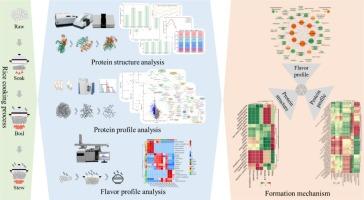当前位置:
X-MOL 学术
›
Food Chem.
›
论文详情
Our official English website, www.x-mol.net, welcomes your
feedback! (Note: you will need to create a separate account there.)
Protein structural properties, proteomics and flavor characterization analysis of rice during cooking
Food Chemistry ( IF 8.5 ) Pub Date : 2024-11-17 , DOI: 10.1016/j.foodchem.2024.142101 Donghao Zhang, Yanpei Cai, Fei Lao, Jihong Wu
Food Chemistry ( IF 8.5 ) Pub Date : 2024-11-17 , DOI: 10.1016/j.foodchem.2024.142101 Donghao Zhang, Yanpei Cai, Fei Lao, Jihong Wu

|
This study analyzed the changes in rice protein structure, protein profiling, and flavor profiles at different cooking stages, as well as their interrelationships. In the continuous cooking process, changes in protein structure characteristics were mainly reflected in the boiling and stewing stages. Protein unfolding and aggregation were important reasons for significant changes in protein structural characteristics. Protein disulfide isomerases and glycine-rich RNA-binding proteins can be used as marker factors to characterize the changes during rice cooking. The concentrations of aldehydes, esters, and alcohols gradually decreased during cooking. Heterocycles were primarily present in boiled and stewed rice. Fatty acid degradation, starch/sucrose metabolism, glycolysis/gluconeogenesis, and other reaction pathways were closely associated with rice aroma quality. Aldehydes, ketones, and heterocycles were correlated with changes in surface hydrophobicity, secondary structure composition, and other structural properties of the protein. This study preliminarily established the relationship between aroma characteristics and rice protein.
中文翻译:

米饭蒸煮过程中的蛋白质结构特性、蛋白质组学和风味表征分析
本研究分析了不同烹饪阶段大米蛋白质结构、蛋白质谱和风味特征的变化,以及它们之间的相互关系。在连续蒸煮过程中,蛋白质结构特性的变化主要体现在煮沸和炖煮阶段。蛋白质去折叠和聚集是蛋白质结构特性发生显著变化的重要原因。蛋白质二硫键异构酶和富含甘氨酸的 RNA 结合蛋白可用作表征煮饭过程中变化的标志因子。醛类、酯类和醇类物质的浓度在蒸煮过程中逐渐降低。杂环主要存在于煮米饭和炖米饭中。脂肪酸降解、淀粉/蔗糖代谢、糖酵解/糖异生等反应途径与稻米香气品质密切相关。醛、酮和杂环与蛋白质表面疏水性、二级结构组成和其他结构特性的变化相关。本研究初步确立了香气特性与大米蛋白的关系。
更新日期:2024-11-18
中文翻译:

米饭蒸煮过程中的蛋白质结构特性、蛋白质组学和风味表征分析
本研究分析了不同烹饪阶段大米蛋白质结构、蛋白质谱和风味特征的变化,以及它们之间的相互关系。在连续蒸煮过程中,蛋白质结构特性的变化主要体现在煮沸和炖煮阶段。蛋白质去折叠和聚集是蛋白质结构特性发生显著变化的重要原因。蛋白质二硫键异构酶和富含甘氨酸的 RNA 结合蛋白可用作表征煮饭过程中变化的标志因子。醛类、酯类和醇类物质的浓度在蒸煮过程中逐渐降低。杂环主要存在于煮米饭和炖米饭中。脂肪酸降解、淀粉/蔗糖代谢、糖酵解/糖异生等反应途径与稻米香气品质密切相关。醛、酮和杂环与蛋白质表面疏水性、二级结构组成和其他结构特性的变化相关。本研究初步确立了香气特性与大米蛋白的关系。


















































 京公网安备 11010802027423号
京公网安备 11010802027423号